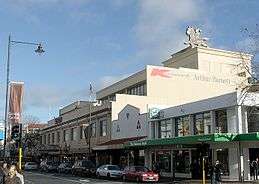Anchor tenant

In retail, an "anchor store" (sometimes called an "anchor tenant", "draw tenant", or "key tenant") is a considerably larger tenant in a shopping mall, often a department store or retail chain. With their broad appeal, they are intended to attract a significant cross-section of the shopping public to the center.
Origins
When the planned shopping centre format was developed by Victor Gruen in the early to mid-1950s, signing larger department stores was necessary for the financial stability of the projects, and to draw retail traffic that would result in visits to the smaller shops in the centre as well. Anchors generally have their rents heavily discounted, and may even receive cash inducements from the centre to remain open.
Classification
The International Council of Shopping Centers makes the presence of anchors one of the main defining characteristics of the two largest categories of centres, the regional center with 400,000 to 800,000 square feet (74,000 m2) in gross leasable area, and the superregional center with more than 800,000 square feet (74,000 m2) of space.
The regional center typically has two or more anchors, while the superregional typically has three or more.
In each case, the anchors account for 50–70% of the centre's leasable space.[1]
Culture
Shopping centres with anchor stores have consistently outperformed those without one, as the anchor helps draw shoppers initially attracted to the anchor to shop at other shops in the mall.[2]
Historical
Early on, grocery stores were a common type of anchor store, since they are visited often. However, research on consumer behavior revealed that most trips to the grocery store did not result in visits to surrounding shops. Large supermarkets remain common anchor stores within power centers however.
As of 2005, the declining popularity of old-line department stores makes it necessary for mall management companies to consider re-anchoring with other retail alternatives, or mix commercial development with residential development to guarantee a captive clientele.
The challenges faced by the traditional large department stores have led to a resurgence in the use of supermarkets[3] and even gyms[4] as anchors.
See also
References
- ↑ "ICSC Shopping Center Definitions: Basic Configurations and Types for the United States" Archived 2007-06-21 at the Wayback Machine., International Council of Shopping Centers. Accessed July 10, 2008.
- ↑ Stoffel, Jennifer. "WHAT'S NEW IN SHOPPING MALLS; Putting a Bloomingdale's in Towns Big and Small", The New York Times, August 7, 1988. Accessed July 10, 2008. "Even as department stores have lost ground to smaller specialty shops, shopping centers with national retailers as anchors continue to outperform those that have only local tenants.... The anchor store has substantial influence - mall plans have been held up until an anchor is firmly in place, and a successful anchor can inspire new development or continued expansion."
- ↑ Kroll, Karen M. (February 1999). "Industry turns to supermarket anchors to fill big boxes". Shopping Centers Today. Archived from the original on 23 September 2009. Retrieved 9 May 2017.
- ↑ Rachel Bachman (2017-11-27). "Malls Never Wanted Gyms. Now They Court Them". Wall Street Journal.